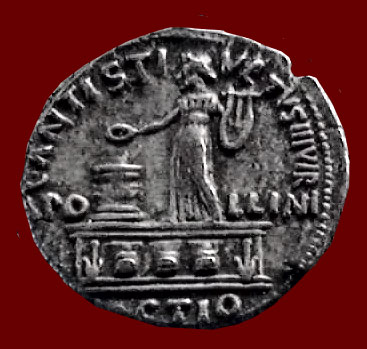
In 28 BCE Augustus Caesar dedicated a major temple on the Palatine to the god Apollo as public tribute for divine assistance in his battles against his political enemies. The battle which came to play a central role in Augustus' campaign to remake Rome was fought against Marc Antony and Cleopatra at Actium in 31 BCE. Actium became most closely associated with the emperor's devotion to Apollo (and Apollo's support for Augustus!), as can be seen in this silver denarius that presents Apollo as responsible for the victory at Actium. Note that the god is holding the lyre and dressed in the same flowing robe as on the statue in the cella of this temple. This coin, minted by C. Antistius Vetus for Augustus in 16 BCE, shows Apollo standing on a podium decorated with ships' rostra and may represent the statue in the temple courtyard.
Although the conflict at the end of the Republic was clearly a civil war, pitting troops loyal to Augustus against those who followed Marc Antony, Augustus was intent on having himself represented as defender of Rome against the foreign legions of Egypt, led by the Egyptian queen. His view came to prevail and became standard both in Roman politics and in poetry. When Vergil describes the shield of Aeneas in Book 8 of the Aeneid, he depicts Apollo ensuring Roman victory and links the god closely with Augustus, actually representing the temple of Apollo on the Palatine as symbolic of Roman victory over foreign foes (niveo limine refers to the white Carrara marble used in this temple):
Actius haec cernens arcum intendebat Apollo desuper; omnis eo terrore Aegyptus et Indi, omnis Arabs, omnes vertebant terga Sabaei.... at Caesar, triplici invectus Romana triumpho moenia, dis Italis votum immortale sacrabat.... ipse sedens niveo candentis limine Phoebi dona recognoscit populorum aptatque superbis postibus; incedunt victae longo ordine gentes, quam variae linguis, habitu tam vestis et armis. (Aeneid 8.704-706; 714-15; 720-23)
Observing these things, Actian Apollo stretched out his bow from above, and every Egyptian, all Indians, every Arab, and all Sabaeans turned their backs in terror of him. . . . But Augustus Caesar, carried into the Roman walls in three-fold triumph, fulfilled his immortal vow to the gods of Italy. . . . He himself, sitting at the white threshold of gleaming Apollo, receives the spoils of the nations and fixes them on the haughty porticus; the conquered peoples march in a long line, as varied in their speech as in the appearance of their clothes and their weapons.
This temple and its complex were part of the massive building program undertaken by Augustus during his almost 50 years of leadership in Rome. In its message it echoes what is to be found at the Forum Augusti and the Ara Pacis. Be sure to visit these other sites here in VRoma.